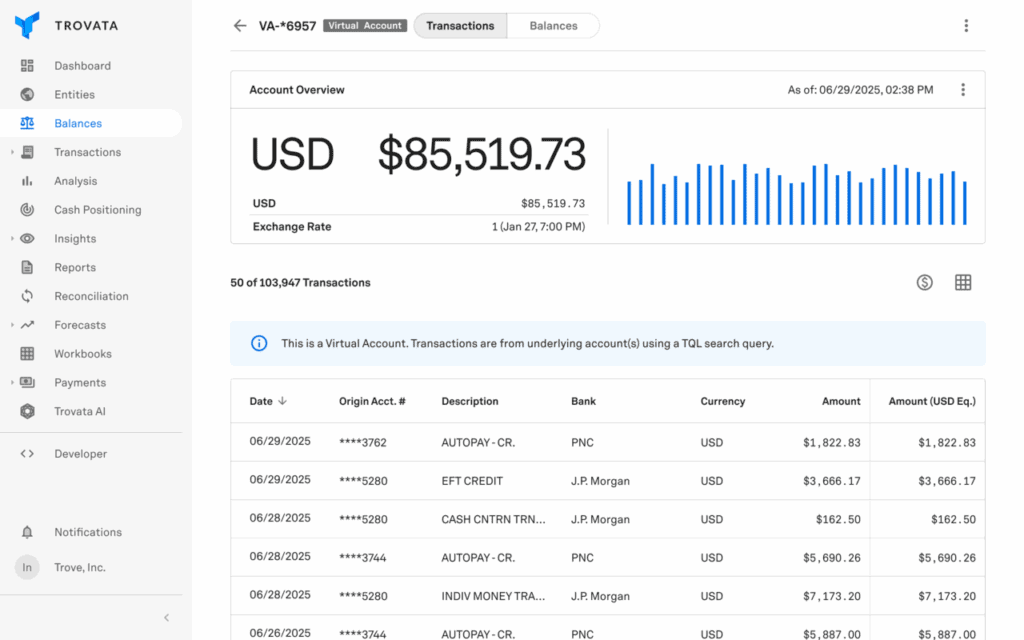Visibility is everything in treasury. If you don’t know exactly how much cash you have and where it sits, it becomes difficult to manage liquidity, support reporting, or guide strategic decisions. That’s why we’re excited to announce the release of Virtual Accounts, a powerful new feature designed to solve persistent reporting gaps and make balance tracking faster and more accurate.
Whether you’re trying to track internal entity balances, manage lines of credit, or reconcile sweep accounts, Trovata’s Virtual Accounts help you do it without relying on error-prone manual processes.
Let’s break down what Virtual Accounts are, who they’re for, and how they work.
What Are Virtual Accounts?

Virtual Accounts are a new account type in Trovata that automatically calculate opening and closing ledger balances based on your existing transaction activity, with no separate balance uploads required.
Instead of maintaining separate balance and transaction files, you can now:
- Define only your transaction-level data (TQL)
- Automatically calculate daily balances
- Use that balance data in reports, forecasts, and dashboards
Virtual Accounts work just like traditional accounts in Trovata, with the added benefit of calculated ledger logic based on the transactions that flow through them.
Why Virtual Accounts Matter
Many treasury teams manage funds that sit outside of traditional account structures, such as pooled accounts, in-house banking arrangements, credit facilities, or overnight sweeps. These often introduce gaps in reporting, because balances aren’t directly available from the bank or require manual reconciliation.
Trovata’s Virtual Accounts close those gaps by automatically generating balances based on transactions. That means:
- Fewer manual uploads
- More accurate reports
- Better visibility across hard-to-track accounts
The result is faster reporting, better decision-making, and fewer hours spent wrangling spreadsheets.
Three Common Use Cases for Virtual Accounts
1. In-House Bank (IHB) Balance Tracking
Large corporates often use a single primary account to fund multiple subsidiaries. While this is efficient from a cash pooling perspective, each entity still needs its own cash reporting.
With Virtual Accounts:
- You can segment activity by entity using TQL logic
- The system will automatically calculate daily balances for each “virtual” account
- Each closing balance rolls into the next day’s opening balance — all automatically
This allows treasury to manage one physical account while reporting separately by business unit or subsidiary.
2. Line of Credit (LOC) Monitoring
Lines of credit are critical liquidity tools, especially when cash flows are uneven or unpredictable. But visibility into how those facilities are used can lag behind reality, especially if drawdowns and repayments happen outside your core banking integrations.
With Virtual Accounts:
- You can manually track LOC usage in Trovata
- Upload drawdown and repayment activity
- Automatically generate a running balance to show credit availability in real-time
No more spreadsheets to track your position. Just plug in the transactions and let Trovata calculate your usage.
3. Overnight Sweep Investment Tracking
Stagecoach sweeps and similar overnight investment vehicles can lead to end-of-day reporting gaps. Because funds are moved out and back in automatically, traditional balance data often doesn’t reflect true cash availability.
With Virtual Accounts:
- You can track sweep activity with daily transactions
- Virtual Accounts automatically calculate balances including swept funds
- You get a clearer picture of true liquidity at any point in time
We’ve Improved Manual Balances Too
As part of this release, we’ve also enhanced how manual accounts work in Trovata. Now, you can convert any manual account to use calculated closing balances based on uploaded transactions. This means:
- No more uploading separate balance files
- Less risk of human error
- Simpler workflows and faster reporting
You’ll still be able to define a starting balance and opening date, but everything after that will be automatically calculated based on transaction data.
Who Should Use Virtual Accounts?
Virtual Accounts were built to support some of the most common (and complex) treasury challenges:
- Companies managing pooled cash structures or in-house banks
- Treasury teams using lines of credit for liquidity coverage
- Clients with Wells Fargo Stagecoach Sweep Accounts or similar structures
- Organizations looking to simplify large-volume manual account tracking
If your team is spending time manually calculating balances across multiple data sources or running into reporting gaps due to system limitations, Virtual Accounts can help.
Getting Started
Using Virtual Accounts is simple:
- Select ‘Create Virtual Account’ from the balances page
- Define your opening date and amount
- Upload or map your TQL to the account
- Enable ‘Offset’ if needed for drawdowns or sweeps
- Watch as Trovata automatically tracks your balance over time
You can create Virtual Accounts for as many entities or structures as needed and use them just like standard accounts in your dashboards, reports, and forecasts.
Say Goodbye to Manual Balance Tracking
Virtual Accounts give treasury teams the flexibility to track hard-to-reach balances with confidence, without waiting for ERP integrations or manual processes. Whether you’re managing pooled cash, credit lines, or investment accounts, Trovata helps you automate the tracking so you can focus on strategy, not spreadsheets.
Want to see Virtual Accounts in action? Book a demo and we’ll show you how they work with your existing data.



